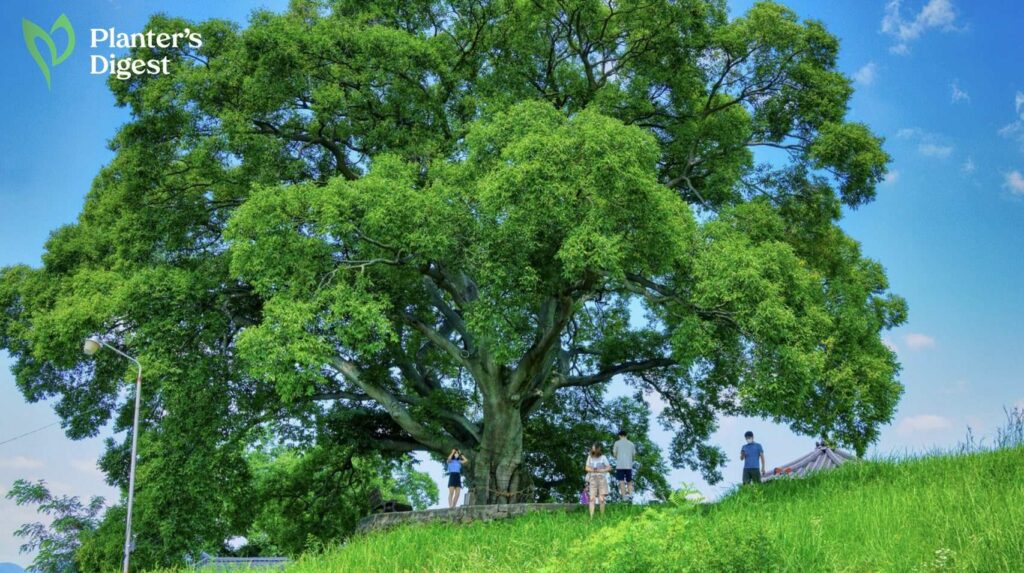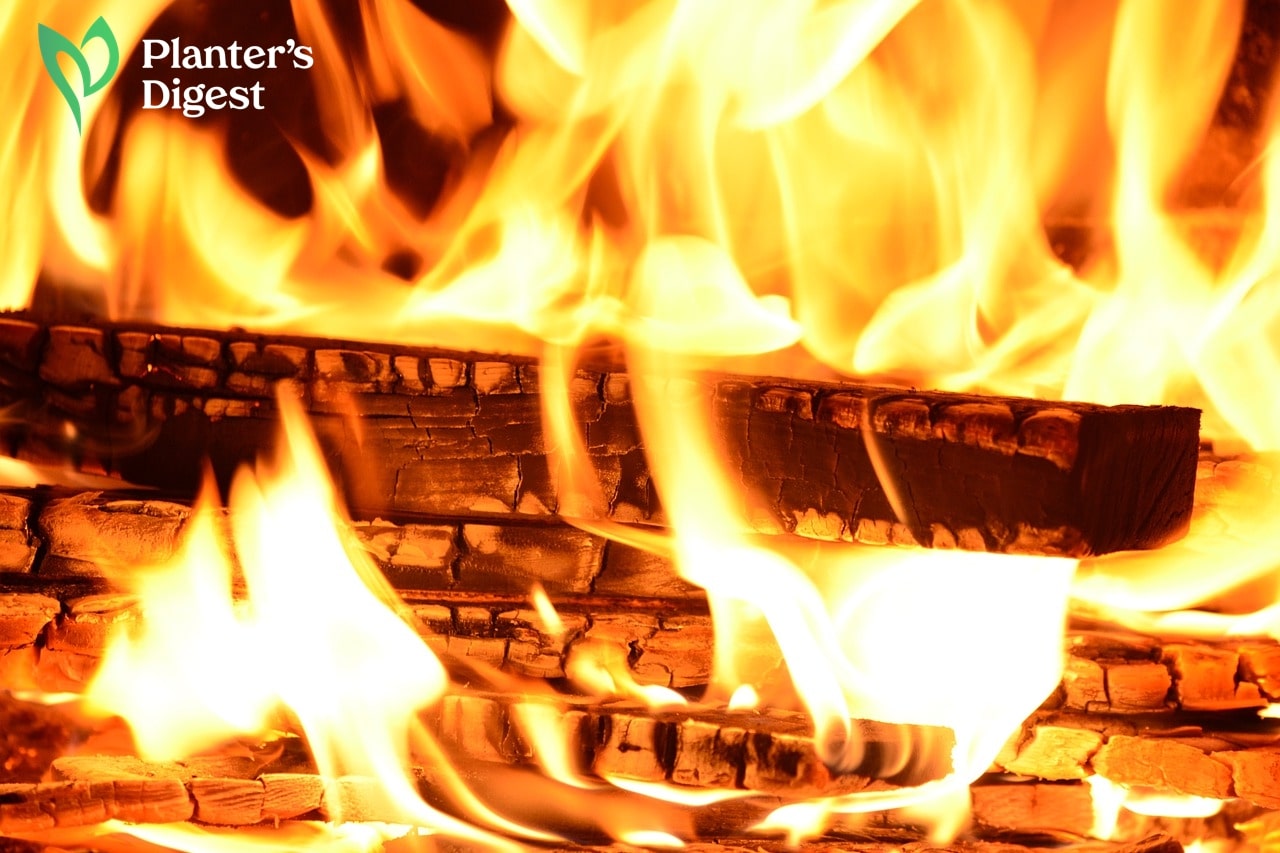
As temperatures slowly drop toward winter, the hunt for reliable firewood to keep you warm begins. Luckily, we’re here to introduce you to hackberry firewood – your perfect companion for long cold winter nights.
In this article, we’ll explore the benefits of hackberry firewood, how it performs in fire compared with other types of wood, and other ways you can use it. Let’s get started!
Is hackberry a good firewood?
Hackberry is a versatile firewood for cooking, fireplaces, log burners, and campfires. It burns clean with a medium heat output of 21.2 million BTUs per cord, little sparks, and a pleasant fragrance.
Hackberry is prized for its clean-burning wood as it produces little smoke, creosote, and sparks, making them suitable for indoor and outdoor burning activities.
It’s also an excellent choice for cooking as it gives off heat and a pleasant smell that can add a smoky flavor to your food.
Check out hackberry firewood’s physical and fire characteristics in the table below.
| Tree Name | Hackberry |
| Scientific Name | Celtis occidentalis |
| Family | Cannabaceae |
| Height | 40 to 60 feet |
| Life Span | 150 to 200 years |
| Type of Wood | Hardwood |
| Dry Weight (lbs per cord) | 3,196 |
| Green Weight (lbs per cord) | 3,984 |
| Seasoning Time | 6 to 12 months |
| Heat Content (million BTUs per cord) | 21.2 |
| Sap Content | Low |
| Splitting Difficulty | Easy |
| Smoke | Low |
| Smell | Pleasant |
| Coal Production | High |
| Creosote Build-up | Low |
What are the varieties of hackberry trees?
Hackberry trees are commonly found in North America, ranging from Mexico to Canada. On average, it grows 50 feet tall and produces small berry-like fruits, a good animal food source.
Common varieties of hackberry species include the Green Cascade, Magnificat, Prairie Pride, Prairie Sentinel, Mediterranean, Netleaf, and Sugarberry trees.
Below is an overview of these common hackberry tree varieties.
| Common Name | Scientific Name | Distribution | Height | Features |
| Green Cascade Hackberry Tree | Celtis occidentalis ‘Green Cascade’ | ChinaJapanAsia | 20 feet | • Has a weeping habit • Green leaves with serrated edges • Fruits are edible and a source of food for birds |
| Magnificat Hackberry Tree | Celtis occidentalis ‘Magnificat’ | ManitobaOntarioQuebecMidwestern United States | 40 feet | • Disease-resistant • Large glossy leaves • Fruits are edible and a source of food for birds |
| Prairie Pride Hackberry Tree | Celtis occidentalis ‘Prairie Pride’ | North America | 30 feet | • Diseases, drought and heat resistant • Fruits are edible and a source of food for birds |
| Prairie Sentinel Hackberry Tree | Celtis occidentalis ‘Prairie Sentinel’ | Western KansasNorth America | 50 feet | • Has an upright growth habit • Fruits are edible and a source of food for birds |
| Mediterranean Hackberry Tree | Celtis australis | EuropeAsiaNorth Africa | 100 feet | • Large leaves with a silvery sheen |
| Netleaf Hackberry Tree | Celtis occidentalis var. reticulata | Southwestern United States | 40 feet | • Relatively small leaves with a net-like appearance |
| Sugarberry Hackberry Tree | Celtis laevigata | Southern United States | 80 feet | • Relatively larger leaves and fruits than common hackberry trees |
Image: Broken Arrow Nursery
The Green Cascade tree is an uncommon hackberry tree variety known for its weeping habit. It’s native to China, Japan and other parts of Asia.
This tree grows about 20 feet tall and spreads up to 25 feet wide, with green leaves that have serrated edges. Its berry-like fruits are a common source of food for birds.
Image: Infodujour
There’s also the Magnificat tree – a hybrid of the common hackberry and sugarberry varieties – resistant to plant diseases.
The Magnificat has large glossy leaves and grows about 40 feet tall and 30 feet wide. Its berries are also edible and a favorite food of birds.
Image: Oakland Nurseries
The Prairie Pride variety is one tough tree that can withstand plant diseases, drought, heat and other adverse weather conditions. In fact, it is the only variety that can resist the witch’s broom disease, which causes spotty dense growth to the tree.
Image: J. Frank Schmidt & Son Co.
On the other hand, the Prairie Sentinel species has a distinct columnar or upright growth habit. It was discovered in Western Kansas and grows about 50 feet tall and 25 feet wide.
Image: IFAS Extension University of Florida
The Mediterranean hackberry is another variety indigenous to Europe, North Africa and Asia. This large tree grows up to 100 feet tall with large leaves and silvery sheens.
Image: Mountain States Wholesale Nursery
Finally, the Netleaf hackberry tree is commonly found in the southwest United States. It has relatively smaller leaves than most hackberry species, which have a distinct net-like appearance.
Fire Characteristics of Hackberry Wood
Hackberry firewood is easy to split with low sap and moisture content while emitting a pleasant smell when burned. It produces a medium heat output and burns cleanly with low smoke, creosote output, and high coal production.
Read on to know how each fire-burning property affects hackberry wood.
1. Easy to Split
Although it’s a hardwood, hackberry is easy to split thanks to its straight grains and low Janka hardness rating of 880 lbf. This means that you need low force to split hackberry wood.
Below is a table that compares hackberry to other firewood as to their Janka hardness rating.
| Firewood | Janka Hardness Rating |
| Hemlock | 540 lbf |
| Hackberry | 880 lbf |
| Red Oak | 1,290 lbf |
| White Oak | 1,360 lbf |
| Hickory | 1,820 lbf |
It even becomes easier to split when the hackberry wood is dried properly. You can split hackberry wood by hand or using an ax.
Fair warning, when you’re splitting green hackberry wood, make sure to rip the log apart manually since it’s a stringy wood while green.
Compared with elm wood with similar heat output, hackberry is still easier to split. Conversely, hackberry is slightly more difficult to break than tamarack or larch woods.
2. Low Sap and Moisture Content
Hackberry has low sap content, which primarily affects its clean-burning capacity. Although it produces some sap or resin, hackberry trees still have low sap content compared with softwoods like fir, pine or cedar.
Hackberry wood also has low moisture content. In fact, when freshly cut, it only has a 64% moisture level, speeding up the wood’s seasoning process.
3. Pleasant Smell
Hackberry releases a pleasant smell that many use to give their food a rich and smoky flavor. Most use this firewood to smoke meat and fish in firepits or barbecues.
Others mix hackberry with oak and other firewood to strengthen its smell as it burns.
4. Medium Heat Output
Hackberry is a medium-quality firewood that can produce 21.2 million BTUs per cord. It produces a decent amount of heat, similar to softwoods like tamarack and douglas fir wood.
Its medium heat output makes it helpful in burning during shoulder seasons or mixed with other firewood for kindling.
See the table below on the heat outputs of common types of firewood compared with hackberry.
| Firewood | Heat Output (million BTUs per cord) |
| Osage Orange | 32.9 |
| White Oak | 29.1 |
| Black Locust | 27.9 |
| Larch | 21.8 |
| Hackberry | 21.2 |
| Cherry | 20.4 |
| Catalpa | 16.4 |
| White Fir | 14.6 |
5. Low Creosote Build-Up
Hackberry releases a low amount of creosote, especially when it’s well-seasoned.
Although every firewood creates creosote, the goal is to burn low-creosote-producing woods like hackberry to lessen its build-up in your flues or chimneys and prevent unwanted fires in your home.
6. Low Smoke Output
Because of its low sap and moisture content, hackberry firewood burns with low smoke output. This makes hackberry firewood ideal for wood stoves, open fireplaces, campfires and firepits.
To get the least smoke, make sure that you season your hackberry wood properly so that it can use its energy to produce heat instead of evaporating the remaining water in the firewood.
7. High Coal Production
One of hackberry firewood’s best features is its high-quality coal production.
These high-quality coals are essential to retain the hot flame throughout the night. Having a good bed of coals will also make it easier to reignite the fire in the morning.
Pros and Cons of Using Hackberry Firewood
| Pros | Cons |
| Easy to split | Prone to fungal attacks |
| Short seasoning time | |
| Burns clean | |
| High-quality coals | |
| Medium heat output | |
| Pleasant smell |
Hackberry is quality firewood with a medium heat output of 21.2 million BTUs per cord while burning cleanly with little smoke, creosote, pops and sparks.
In terms of preparation, it’s very easy to split because of its straight grains, and its low moisture content makes its seasoning time shorter, only between 6 to 12 months.
Hackberry is one of the few firewoods that can add flavor to food, with its pleasant aroma giving a smoky flavor to whatever you’re cooking.
It also produces high-quality coals, which can sustain its hot flames when used as an overnight heating source during cold winter nights or to cook food.
However, hackberry firewood has its challenges. It’s prone to fungal, rot and attacks, so you’ll need to make sure it’s kept in a dry place to prevent infestation and speed up its seasoning period.
How does hackberry compare with other firewood?
Hackberry produces a decent amount of heat, better than most softwoods. However, it’s not at the same level as the hottest burning hardwoods like osage orange, gambel oak, black locust and beach firewood.
Unlike most hardwoods, hackberry is very easy to split because of its straight grains, while its low moisture content is significantly lower than oak, pine and honey locust.
How long should you season hackberry wood?
Hackberry wood needs about 6 to 12 months to completely dry out and be ready for firewood use.
It’s best to complete its seasoning period to make sure it releases little smoke, creosote, and sparks when burned.
Once you achieve a 20% or lower moisture content of the hackberry wood, you can now use it as firewood.
FAQs on Hackberry Firewood
Hackberry wood is not toxic as it emits little smoke when burned. However, working with hackberry as timber releases a lot of sawdust and cause skin irritation and allergies to some people.
Hackberry trees are easily identified through the wart-like and corky ridges from their light-colored bark. It usually grows between 40 to 60 feet in most soil types and can adapt to various weather conditions.
A cord of dry hackberry wood weighs 3,196 lbs, while green hackberry wood weighs 3,984 lbs.
The best time to chop down hackberry trees for firewood is between winter and early spring when it has less sap and moisture, which will help speed up their seasoning process.
Hackberry firewood is an excellent choice for smoking meat as it imparts a mild, sweet, smoky flavor to pork, chicken, or fish. It produces little smoke that will not overwhelm the taste of your food.




